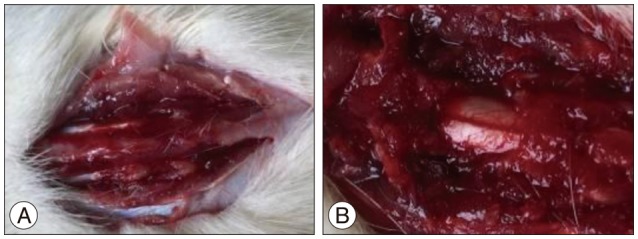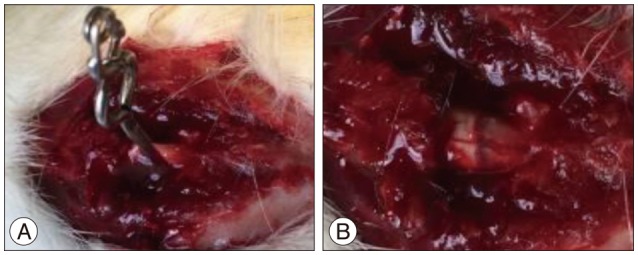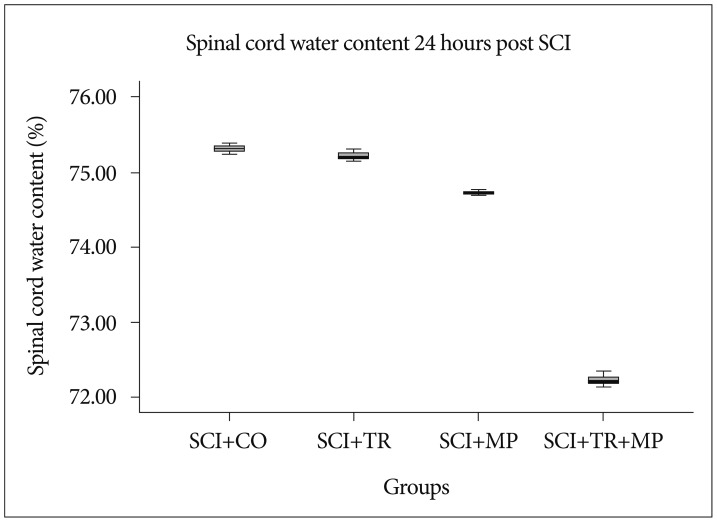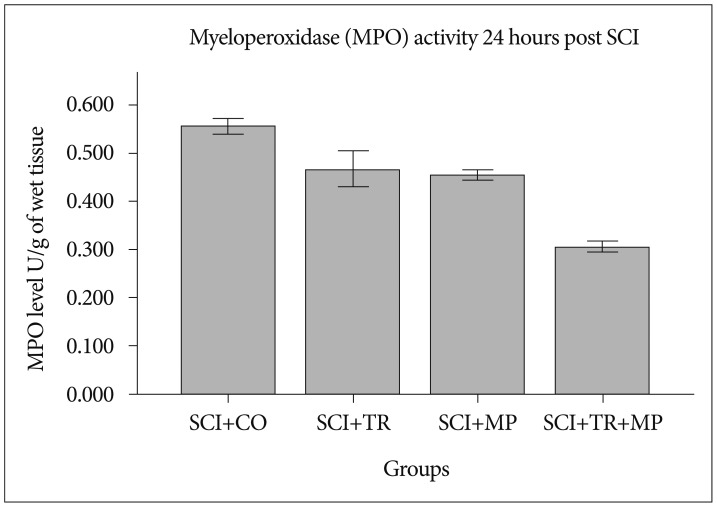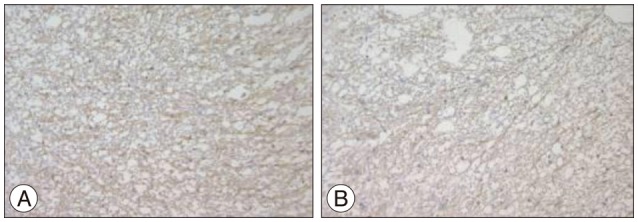J Korean Neurosurg Soc.
2016 Jul;59(4):334-340. 10.3340/jkns.2016.59.4.334.
Evaluation of the Combination of Methylprednisolone and Tranilast after Spinal Cord Injury in Rat Models
- Affiliations
-
- 1Department of Orthopedic Surgery (Unit III), First Affiliated Hospital of Jiamusi University, Heilongjiang Province, Jiamusi City, China. zipromax@163.com
- 2Department of Neurosurgery, First Affiliated Hospital of Jiamusi University, Heilongjiang Province, Jiamusi City, China.
- KMID: 2315966
- DOI: http://doi.org/10.3340/jkns.2016.59.4.334
Abstract
OBJECTIVE
The aim of our study was to evaluate the neuroprotective functions of the combination therapy using methylprednisolone (MP) and tranilast (TR) after spinal cord injury (SCI) in adult rats.
METHODS
Spinal cord compression injury model was achieved using Yasargil aneurysm clip. Rats were divided into control group, MP group, TR group, and combination therapy group using TR and MP. Rat models were assessed for locomotor functional recovery using Basso, Beattie, and Bresnahan (BBB) score, spinal cord water content and myeloperoxidase (MPO) activity 24 hours post SCI, haematoxylin and eosin staining and glial fibrillary acid protein (GFAP) staining at 7 and 14 days post SCI.
RESULTS
The spinal cord water content and MPO activity in the combination therapy group was significantly lower than the control group and the individual therapy groups p<0.05. The combination therapy group had significantly higher BBB scores than control group and individual therapy groups (p<0.05). At one week after SCI, GFAP expression in the combination group was significantly lower than the control group (p<0.05) but there was no significant difference compared to the individual therapy groups (p>0.05). At 2 weeks after SCI there was a slight decrease in GFAP expression compared to the first week but the difference was not statistically significant (p>0.05), GFAP expression between the groups was not statistically significant p>0.05.
CONCLUSION
Combining MP and TR is therapeutically more effective in improving functional recovery, inhibiting inflammation and glial scar formation after acute SCI.
MeSH Terms
Figure
Reference
-
1. Alovskaya A, Alekseeva T, Phillips JB, King V, Brown R. Fibronectin, collagen, fibrin components of extracellular matrix for nerve regeneration. In : Ashammakhi N, Reis RL, Chiellini E, editors. Topics in Tissue Engineering, Chapter 12. Expertissues (ebook). 2007. Vol 3:Available from: http://oro.open.ac.uk/9064/.2. Basso DM, Beattie MS, Bresnahan JC. A sensitive and reliable locomotor rating scale for open field testing in rats. J Neurotrauma. 1995; 12:1–21. PMID: 7783230.
Article3. Bracken MB. Pharmacological interventions for acute spinal cord injury. Cochrane Database Syst Rev. 2000; (2):CD001046. PMID: 10796741.4. Bradbury EJ, McMahon SB. Spinal cord repair strategies : why do they work? Nat Rev Neurosci. 2006; 7:644–653. PMID: 16858392.5. Dumont RJ, Okonkwo DO, Verma S, Hurlbert RJ, Boulos PT, Ellegala DB, et al. Acute spinal cord injury, part I : pathophysiologic mechanisms. Clin Neuropharmacol. 2001; 24:254–264. PMID: 11586110.6. Gerndt SJ, Rodriguez JL, Pawlik JW, Taheri PA, Wahl WL, Micheals AJ, et al. Consequences of high-dose steroid therapy for acute spinal cord injury. J Trauma. 1997; 42:279–284. PMID: 9042882.
Article7. Grimpe B, Silver J. A novel DNA enzyme reduces glycosaminoglycan chains in the glial scar and allows microtransplanted dorsal root ganglia axons to regenerate beyond lesions in the spinal cord. J Neurosci. 2004; 24:1393–1397. PMID: 14960611.
Article8. Hanada M, Tsutsumi K, Arima H, Shinjo R, Sugiura Y, Imagama S, et al. Evaluation of the effect of tranilast on rats with spinal cord injury. J Neurol Sci. 2014; 346:209–215. PMID: 25194634.
Article9. Hsu CY, Dimitrijevic MR. Methylprednisolone in spinal cord injury : the possible mechanism of action. J Neurotrauma. 1990; 7:115–119. PMID: 2258942.
Article10. Jazayeri SB, Firouzi M, Abdollah Zadegan S, Saeedi N, Pirouz E, Nategh M, et al. The effect of timing of decompression on neurologic recovery and histopathologic findings after spinal cord compression in a rat model. Acta Med Iran. 2013; 51:431–437. PMID: 23945885.11. Kopp MA, Liebscher T, Niedeggen A, Laufer S, Brommer B, Jungehulsing GJ, et al. Small-molecule-induced Rho-inhibition : NSAIDs after spinal cord injury. Cell Tissue Res. 2012; 349:119–132. PMID: 22350947.
Article12. Lagord C, Berry M, Logan A. Expression of TGFbeta2 but not TGFbeta1 correlates with the deposition of scar tissue in the lesioned spinal cord. Mol Cell Neurosci. 2002; 20:69–92. PMID: 12056841.
Article13. Lee BH, Lee KH, Yoon DH, Kim UJ, Hwang YS, Park SK, et al. Effects of methylprednisolone on the neural conduction of the motor evoked potentials in spinal cord injured rats. J Korean Med Sci. 2005; 20:132–138. PMID: 15716618.
Article14. Li Z, DU J, Sun H, Mang J, He J, Wang J, et al. Effects of the combination of methylprednisolone with aminoguanidine on functional recovery in rats following spinal cord injury. Exp Ther Med. 2014; 7:1605–1610. PMID: 24926352.
Article15. Liu WL, Lee YH, Tsai SY, Hsu CY, Sun YY, Yang LY, et al. Methylprednisolone inhibits the expression of glial fibrillary acidic protein and chondroitin sulfate proteoglycans in reactivated astrocytes. Glia. 2008; 56:1390–1400. PMID: 18618653.
Article16. Matsumoto T, Tamaki T, Kawakami M, Yoshida M, Ando M, Yamada H. Early complications of high-dose methylprednisolone sodium succinate treatment in the follow-up of acute cervical spinal cord injury. Spine (Phila Pa 1976). 2001; 26:426–430. PMID: 11224891.
Article17. Messina S, Bitto A, Aguennouz M, Mazzeo A, Migliorato A, Polito F, et al. Flavocoxid counteracts muscle necrosis and improves functional properties in mdx mice : a comparison study with methylprednisolone. Exp Neurol. 2009; 220:349–358. PMID: 19786019.
Article18. Miyazawa K, Hamano S, Ujiie A. Antiproliferative and c-myc mRNA suppressive effect of tranilast on newborn human vascular smooth muscle cells in culture. Br J Pharmacol. 1996; 118:915–922. PMID: 8799562.
Article19. Moon LD, Fawcett JW. Reduction in CNS scar formation without concomitant increase in axon regeneration following treatment of adult rat brain with a combination of antibodies to TGFbeta1 and beta2. Eur J Neurosci. 2001; 14:1667–1677. PMID: 11860461.
Article20. Mullane K. Neutrophil-platelet interactions and post-ischemic myocardial injury. Prog Clin Biol Res. 1989; 301:39–51. PMID: 2678130.21. Nakazawa M, Yoshimura T, Naito J, Azuma H. [Pharmacological properties of N-(3',4'-dimethoxycinnamoyl) anthranilic acid (N-5'), a new anti-atopic agent. (4).--Anti-inflammatory activity of N-5' (author's transl)]. Nihon Yakurigaku Zasshi. 1978; 74:473–481. PMID: 700512.22. Nie L, Mogami H, Kanzaki M, Shibata H, Kojima I. Blockade of DNA synthesis induced by platelet-derived growth factor by tranilast, an inhibitor of calcium entry, in vascular smooth muscle cells. Mol Pharmacol. 1996; 50:763–769. PMID: 8863820.23. Parry PV, Engh JA. Promotion of neuronal recovery following experimental SCI via direct inhibition of glial scar formation. Neurosurgery. 2012; 70:N10–N11.
Article24. Sharma A. Pharmacological management of acute spinal cord injury. J Assoc Physicians India. 60(Suppl):2012; 13–18.25. Silver J, Miller JH. Regeneration beyond the glial scar. Nat Rev Neurosci. 2004; 5:146–156. PMID: 14735117.
Article26. Spiecker M, Lorenz I, Marx N, Darius H. Tranilast inhibits cytokine-induced nuclear factor kappaB activation in vascular endothelial cells. Mol Pharmacol. 2002; 62:856–863. PMID: 12237332.
Article27. Suzawa H, Kikuchi S, Ichikawa K, Arai N, Tazawa S, Tsuchiya O, et al. [Effect of tranilast, an anti-allergic drug, on the human keloid tissues]. Nihon Yakurigaku Zasshi. 1992; 99:231–239. PMID: 1376711.
Article28. Tanaka K, Honda M, Kuramochi T, Morioka S. Prominent inhibitory effects of tranilast on migration and proliferation of and collagen synthesis by vascular smooth muscle cells. Atherosclerosis. 1994; 107:179–185. PMID: 7526874.
Article29. Yan P, Xu J, Li Q, Chen S, Kim GM, Hsu CY, et al. Glucocorticoid receptor expression in the spinal cord after traumatic injury in adult rats. J Neurosci. 1999; 19:9355–9363. PMID: 10531440.
Article30. Yang P, He X, Qu J, Li H, Lan B, Yuan P, Wang G. [Expression of nestin and glial fibrillary acidic protein in injured spinal cord of adult rats at different time]. Zhongguo Xiu Fu Chong Jian Wai Ke Za Zhi. 2005; 19:411–415. PMID: 16038450.
- Full Text Links
- Actions
-
Cited
- CITED
-
- Close
- Share
- Similar articles
-
- Pre-injury Treatment of Methylprednisolone in Experimental Spinal Cord Injury
- Effect of Methylprednisolone on the Lactate Metabolism in Experimental Spinal Cord Injury
- Therapeutic time window for methylprednisolone in spinal cord injured rat
- Acute Effect of Methylprednisolone in Experimental Spinal Cord Injury
- Recent Advances in the Pathophysiology and Treatment of Acute Spinal Cord Injury

